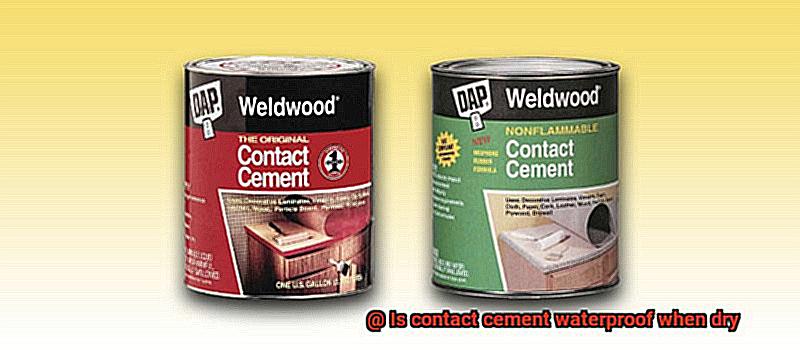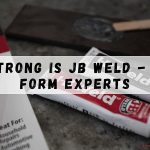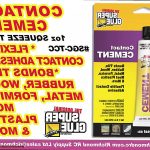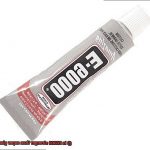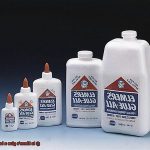Today, we’re delving deep into the world of contact cement to uncover its waterproof superpowers when it’s all dried up. Whether you’re a craft fanatic, a design hobbyist, or just someone curious about adhesives, chances are you’ve wondered about this very question.
Can contact cement truly stand strong against moisture? Well, prepare to be blown away as we unravel the secrets behind this popular glue.
Come along with us on this adventure as we explore every nook and cranny of contact cement and find out if it’s the waterproof wonder you’ve been searching for in your projects.
What is Contact Cement?
Contents
- 1 What is Contact Cement?
- 2 Is Contact Cement Waterproof when Dry?
- 3 Why is Contact Cement Not Waterproof when Dry?
- 4 Variations of Contact Cement That Are Water-Resistant or Waterproof When Dry
- 5 What to Consider When Choosing a Waterproof Adhesive
- 6 Different Types of Waterproof Adhesives
- 7 Benefits of Using a Waterproof Adhesive
- 8 Conclusion
Known for its exceptional bonding strength and fast-drying properties, contact cement is a go-to choice for various projects. However, there is often confusion about its waterproof capabilities. In this article, we will delve into what contact cement is, its uses, and its suitability for waterproof applications.
Understanding Contact Cement:
Contact cement is composed of natural or synthetic rubber, solvents, and resins. This unique combination allows it to create permanent bonds between different materials such as wood, metal, plastic, fabric, laminate, veneer, and foam. Unlike other adhesives, contact cement does not require clamping or extended drying time due to its fast-drying nature.
The Bonds that Last:
When applied correctly, contact cement forms an incredibly strong bond that is difficult to separate. The process involves brushing or rolling the adhesive onto both surfaces to be bonded and allowing the solvent to evaporate before joining them together. Once the solvent has completely evaporated, the bond becomes permanent.
Waterproof Considerations:
While contact cement provides an excellent bond between surfaces, it is generally not considered completely waterproof when dry. Its composition allows for some permeability to water and moisture. Prolonged contact with water can cause contact cement to soften and lose its adhesive properties, potentially leading to the separation of bonded surfaces.
Specialized Waterproof Adhesives:
For projects that require waterproof bonds, it is advisable to opt for specialized waterproof adhesives instead of solely relying on contact cement. These adhesives are specifically formulated to withstand exposure to water and moisture without compromising their bonding capabilities. They often contain additives that enhance water resistance and provide long-lasting protection against water penetration.
Is Contact Cement Waterproof when Dry?
Today, we’re diving deep into the world of adhesives to answer a burning question: Is contact cement waterproof when dry? Get ready for a journey through the factors that affect its water resistance and valuable tips to keep your glued projects intact, rain or shine.
So, is contact cement waterproof when dry? Well, it’s a bit of a mixed bag. The answer depends on the specific brand and formulation you’re using. Some varieties are indeed water-resistant when dry, thanks to special additives that create a protective barrier against moisture infiltration. Picture it as a shield, guarding your glued masterpiece from the elements. These are your go-to options for outdoor furniture, boats, or even bathroom projects.
However, not all contact cements are created equal. Some may not be as water-resistant as their counterparts, leaving your carefully glued creation vulnerable to water damage. To determine if your contact cement is waterproof when dry, always read the product label or consult the manufacturer’s specifications. Don’t leave it up to chance.
Now, even if you’re working with a waterproof contact cement, it’s essential to take additional precautions to safeguard your adhesive bond. Remember, excessive exposure to water or extreme conditions can still compromise its performance over time. Here are some handy tips:
- Apply a waterproofing sealant: Once your contact cement has dried, consider adding an extra layer of protection by applying a waterproof sealant over the glued surfaces. Think of it as an insurance policy for your bond.
- Use a primer or sealant: Before applying the contact cement, prime or seal the surfaces being bonded. This extra step can provide an added layer of protection against moisture infiltration. It’s like putting on sunscreen before hitting the beach.
- Ensure proper ventilation and drainage: If you’re working in an area prone to moisture or water exposure, such as a bathroom or outdoor setting, make sure there is adequate ventilation and drainage to prevent water from pooling around your glued project. Think of it as creating a safe haven for your bond to thrive.
By taking these precautions and using a waterproof contact cement, you’ll enhance the longevity and durability of your bonded materials. So, whether you’re a DIY enthusiast or a professional craftsman, choose the right adhesive for the job and protect your projects from the elements.
Why is Contact Cement Not Waterproof when Dry?
Prepare to be amazed as we delve into the captivating chemistry behind this phenomenon and uncover the reasons why contact cement is not waterproof when dry.
Chemical Composition and Curing Process:
Contact cement boasts a mixture of solvents, rubber polymers, and resins. When applied, the solvents evaporate, allowing the rubber and resin components to form a bond with the surface. However, during the curing process, the solvents completely evaporate, leaving behind a solid layer that lacks the same impermeability as the original adhesive.
Mechanical Adhesion vs. Chemical Bonding:
Unlike adhesive counterparts like epoxy or polyurethane-based glues that establish chemical bonds with surfaces, contact cement relies on mechanical adhesion. It clings to surfaces physically, granting it a quick bonding strength. However, this mechanical adhesion makes it more prone to water infiltration and less capable of withstanding moisture exposure.
The Porous Predicament:
The dried layer of contact cement presents a porous nature that becomes its Achilles’ heel in water resistance. Water molecules easily seep into the gaps of this porous layer, sabotaging the adhesive’s bond with the surface. Prolonged water exposure can even degrade the rubber and resin components over time, further compromising its performance.
Alternatives for Water Resistance:
When water resistance is paramount, alternative adhesives like epoxy or polyurethane-based glues take center stage. These adhesives engage in chemical bonding with surfaces, offering superior waterproof properties compared to contact cement. They thrive in environments where moisture or water exposure is an inevitable reality.
Variations of Contact Cement That Are Water-Resistant or Waterproof When Dry
This adhesive superhero has long been the savior of bonding materials together with its Herculean strength and lightning-fast drying time. However, a challenge arises – traditional contact cement is not known for its prowess in water resistance.
Today, we shall embark on a captivating journey into the realm of water-resistant and waterproof variations of contact cement that will keep your projects afloat in any aquatic escapade.
Water-Resistant Contact Cement:
Let us first acquaint ourselves with the trusty sidekick of traditional contact cement – water-resistant contact cement. This magical variation is concocted with special additives that form an impenetrable shield against moisture. These mystical ingredients repel water damage, safeguarding your bond from weakening or crumbling under soggy conditions. Whether you’re renovating a bathroom or crafting something prone to the occasional splash, fear not, for water-resistant contact cement is your unwavering ally.
Waterproof Contact Cement:
Now, brace yourselves for the heavyweight champion – waterproof contact cement. This adhesive superhero takes water resistance to uncharted heights by triumphantly enduring prolonged exposure to H2O without relinquishing its adhesive might.
Picture this: outdoor projects defiantly facing the elements, high-humidity environments, or even underwater endeavors – waterproof contact cement emerges triumphant with indomitable strength.
Tips for Optimal Water Resistance:
Remember, even with water-resistant or waterproof contact cement, extended encounters with water can gradually weaken the bond. To maximize your adhesive’s aqua-repelling power, here are some handy tips:
- Follow Instructions: Immerse yourself in the wisdom contained within the manufacturer’s instructions to ensure precise application and achieve the desired level of water resistance. Do not underestimate this crucial step.
- Take Precautions: While these adhesive marvels perform miracles, it is wise to minimize continuous exposure of bonded materials to water whenever possible. Prevention is the cornerstone of success.
Enhancing Water Resistance:
But wait, there’s more. If you find yourself working with traditional contact cement and yearning for an extra layer of water resistance, fret not. Solutions abound. Consider applying a waterproof sealant over the dried adhesive or utilizing specialized primers that amplify its moisture-defying capabilities. These techniques will elevate your contact cement game to unprecedented levels.
Choosing the Right Contact Cement:
When selecting contact cement for optimal water resistance, it is vital to consider the unique requirements of your project. Whether it involves perusing product labels, consulting esteemed experts at hardware stores, or embarking on an online quest for knowledge, finding the perfect match will ensure your bond remains unwavering and watertight.
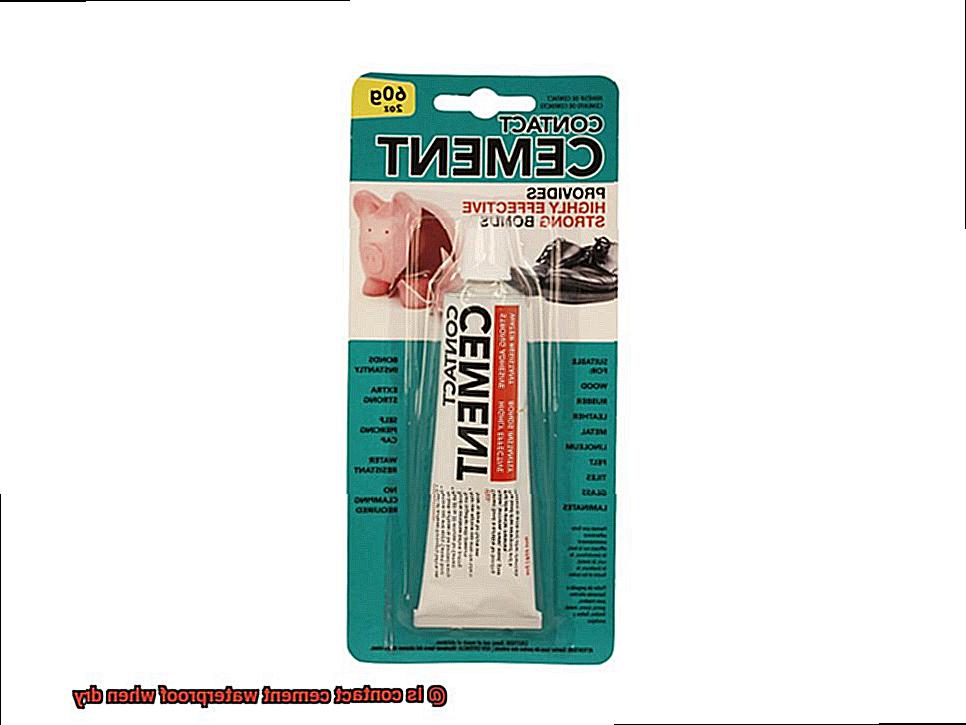
What to Consider When Choosing a Waterproof Adhesive
Whether you’re crafting a masterpiece or constructing a structure, selecting the right waterproof adhesive can make all the difference in the success of your endeavor. Let’s dive deeper into what you need to consider when choosing the perfect glue for your needs.
Material Compatibility:
Just as the ocean teems with diverse life forms, adhesives come in different types and are designed for specific materials. Consider the materials you are working with – wood, metal, plastic, or others – and choose an adhesive that is compatible with them. Some adhesives excel at bonding certain materials, ensuring a strong and durable connection. By selecting an adhesive that is tailored to your materials, you’ll ensure a bond that can withstand any storm.
Environmental Conditions:
Imagine your project facing the elements – rain, humidity, or even underwater exposure. It’s crucial to select an adhesive that can weather these conditions. Look for adhesives specifically designed to be waterproof or water-resistant.
These adhesives have special formulations that prevent them from weakening or breaking down when exposed to moisture. By choosing an adhesive that can handle the environment it will be used in, you’ll ensure a bond that stands up to any challenge.
Strength and Flexibility:
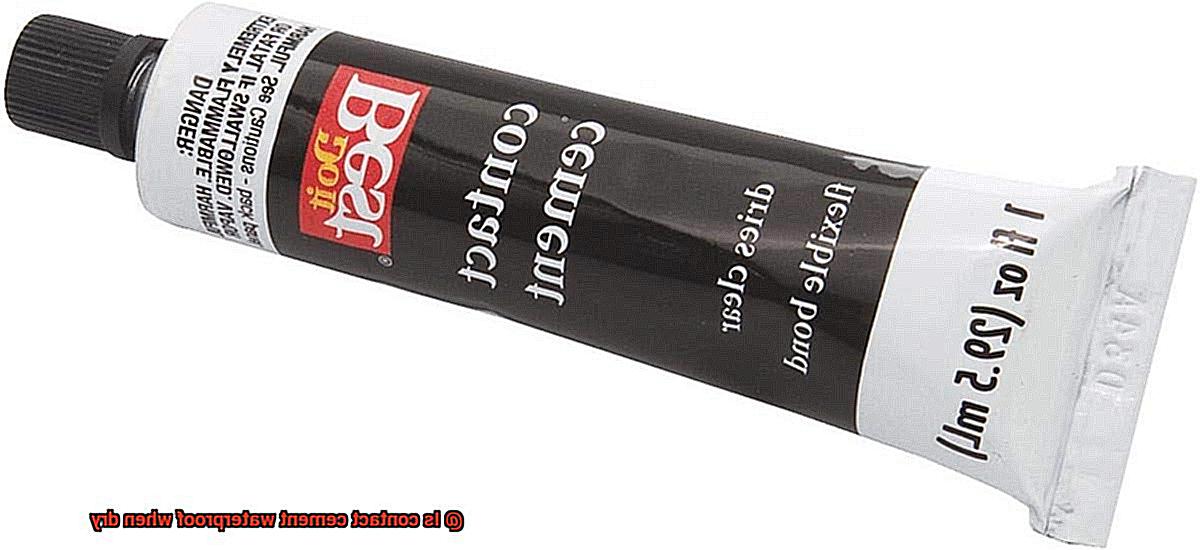
Consider the demands of your project – will it bear heavy loads or experience movement? The strength and flexibility of your adhesive are critical factors to ensure a long-lasting bond. Some adhesives provide exceptional strength, capable of holding together even under significant stress. Others offer flexibility to accommodate movement or expansion without compromising the bond. By understanding the specific requirements of your project, you’ll choose an adhesive that provides the perfect balance of strength and flexibility.
Application Method:
Think about how you want to apply the adhesive – is it a pre-mixed formula or does it require mixing? Consider your comfort level and experience with different application methods. Pre-mixed adhesives are convenient and ready to use, while adhesives that require mixing allow for precise control over the consistency. By selecting an adhesive with an application method that suits your needs, you’ll set the stage for a seamless bonding process.
Additional Features:
Sometimes, you need that extra touch to make your project shine. Consider any additional features or benefits that may be important for your specific project. Some adhesives offer quick drying times, perfect for projects with tight deadlines. Others provide UV resistance or high-temperature resistance, crucial for projects exposed to sunlight or extreme heat. By choosing an adhesive with the right set of additional features, you’ll ensure your project stands out from the rest.
Different Types of Waterproof Adhesives
Choosing the right adhesive is paramount when joining materials together, and in situations where water resistance is a must, waterproof adhesives become the heroes of the project. In this guide, we will dive into the different types of waterproof adhesives available in the market, exploring their unique properties and applications.
Contact Cement: A Versatile Friend
Contact cement acts as a trusty sidekick in woodworking, construction, and beyond. Known for its quick-drying properties and high bond strength, contact cement provides reliable adhesion. However, it’s important to note that contact cement is not inherently waterproof. Certain variations labeled as “waterproof” or “water-resistant” are available to ensure peace of mind in damp environments.
Epoxy Resin: The Mighty Marine Warrior
When facing projects in marine settings or requiring adhesives that withstand water exposure, epoxy resin emerges as the go-to choice. With its excellent bonding strength and resistance to water, chemicals, and heat, epoxy adhesives are perfect for boat repairs, underwater repairs, or any project facing harsh water conditions.
Polyurethane Adhesives: Flexibility at Its Finest
When flexibility and durability are paramount, polyurethane adhesives take center stage. These adhesives offer excellent resistance to water and moisture, making them ideal for outdoor applications or areas prone to water exposure. From sealing joints in windows and doors to assembling outdoor furniture, polyurethane adhesives have got you covered.
Silicone Adhesives: The Sealant Superstars
Sealing gaps and joints in wet areas like bathrooms or kitchens requires sealant superheroes – silicone adhesives. With exceptional resistance to water, UV radiation, and extreme temperatures, silicone adhesives ensure a waterproof seal that lasts. Count on them for tile repairs, plumbing fixtures, and any project where water-tightness is essential.
Benefits of Using a Waterproof Adhesive
Waterproof adhesives offer numerous benefits that make them the ideal choice for a wide range of applications. These adhesives are specially designed to provide a strong bond that is resistant to water and moisture, making them perfect for outdoor projects or areas prone to high humidity. Let’s explore the key advantages of using a waterproof adhesive.
First and foremost, the most significant benefit of using a waterproof adhesive is its ability to maintain its bond strength even when exposed to water or submerged in water for extended periods. This is crucial in applications where the adhesive will be subjected to moisture, such as in marine environments or bathroom installations.
Furthermore, waterproof adhesives are resistant to deterioration caused by water. Unlike non-waterproof adhesives that may break down or lose their effectiveness when exposed to moisture, waterproof adhesives are formulated to withstand these conditions, ensuring long-lasting durability.
Flexibility is another key advantage of waterproof adhesives. They can adapt to the expansion and contraction of materials due to temperature changes or environmental conditions. This flexibility helps prevent the adhesive from cracking or becoming brittle over time, guaranteeing a strong and reliable bond that stands the test of time.
In addition to their resistance to water, many waterproof adhesives also offer excellent resistance to other elements like UV radiation, chemicals, and extreme temperatures. This versatility makes them suitable for a wide range of applications, including outdoor signage, automotive repairs, and industrial bonding.
Using a waterproof adhesive can also provide added protection against mold and mildew growth. These adhesives create a barrier that prevents the growth of these microorganisms by not absorbing moisture. So not only will your bond stay strong, but you’ll also maintain a cleaner and healthier environment.
But the benefits don’t stop there – waterproof adhesives are also easier to work with compared to non-waterproof options. They typically have longer open times, allowing users more time for positioning and adjusting before the adhesive sets. This can be especially helpful when working on complex projects or bonding large surfaces.
When it comes to versatility, waterproof adhesives are the true champions. They can be used on a wide range of materials, including wood, metal, plastic, ceramic, and more. So no matter what materials you’re working with, a waterproof adhesive will get the job done.
Last but not least, using a waterproof adhesive can save you time and money in the long run. Since these adhesives provide a strong and durable bond, they reduce the need for frequent repairs or replacements. This is particularly advantageous for projects that are exposed to water or moisture regularly, as they require a reliable adhesive to ensure longevity.
mLhgAPlY7lw” >
Conclusion
In conclusion, contact cement falls short of being completely waterproof when it dries. Although it creates a formidable bond between surfaces, extended exposure to water can cause it to lose its grip and become pliable. However, fear not. There are variations of contact cement that proudly boast labels like “water-resistant” or “waterproof,” providing robust defense against moisture.
When selecting an adhesive that laughs in the face of water, several factors must be considered. Material compatibility, environmental conditions, strength and flexibility requirements, application method, and additional features all play a role in making the right choice.
For projects in marine settings or those demanding resistance to water, chemicals, and heat, epoxy resin reigns supreme. If you’re seeking flexibility and durability for outdoor applications, look no further than polyurethane adhesives. And for sealing gaps and joints in wet areas like bathrooms? Silicone adhesives are your trusty sidekick.
The benefits of using a waterproof adhesive are plentiful. It guarantees an unyielding bond that stands tall against the relentless assault of water and moisture over time. Waterproof adhesives scoff at deterioration caused by water while effortlessly accommodating material expansion and contraction. They even shrug off UV radiation, chemicals, and extreme temperatures with ease. As if that weren’t enough, they provide an extra layer of protection against the dreaded duo of mold and mildew growth.
All things considered, while contact cement may not possess inherent waterproof qualities when dry, fear not.
Specialized waterproof adhesives exist to save the day across various applications.

